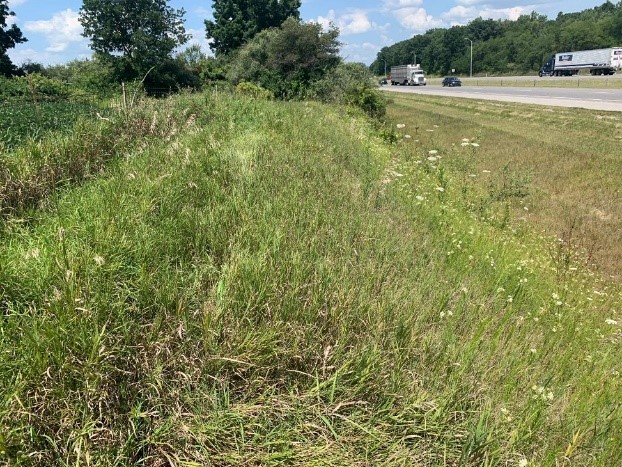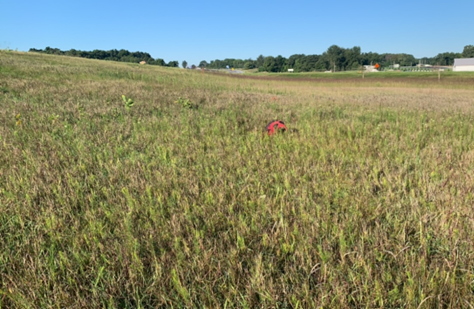April 2023
INDOT is helping ensure the wondrous flight of the monarch butterfly.
In March, our agency captured two awards during ceremonies for transportation and energy organizations making efforts to ensure the survival of the migratory butterfly, which is listed as an endangered species by the International Union for Conservation of Nature (IUCN).
INDOT took first place in the Flight Tracker category for most monarch observations in monitoring plots in 2022. A contracted environmental consulting firm conducted the survey work.
We also won in the Asclepias Adder category for highest average milkweed stems across monitoring plots in 2022. Milkweed plants serve as the butterflies’ nursery, food source, and home.
Monarchs can travel nearly 3,000 miles from the northern United States and southern Canada to their overwintering destination in Mexico. There, at the Monarch Butterfly Biosphere Reserve in Mexico, monarchs congregate by the millions in the oyamel fir forests. By the start of spring, monarchs are ready to mate and migrate back to the U.S. They fly 1,000 miles to lay their eggs only on milkweed plants, which will eventually serve as a food source for the caterpillars.
“That’s why our rights-of-way are so important,” said Roadside Maintenance Specialist Matt Kraushar, who represented INDOT at the awards ceremony. “We mow only to 15 feet from the roadway during the growing season for a reason. Instead of blanket mowing, we mow to maintain sight distance and focus other management efforts on invasive species and noxious weeds in a targeted manner. Other native plants, like milkweed, that grow in the right-of-way and are sometimes referred to as “weeds,” are very important habitat for pollinator species like monarchs, small wildlife, songbirds, and even rare plants. That is why we are so intentional in our management efforts and leave those wildflowers alone.”
Kraushar added that dead standing brush and standing residual stems from the previous year’s flowers are vital overwintering areas on INDOT rights-of-way for many insects and other species. Even though these areas don’t “look nice,” they still serve a very important function.
With the help of the Environmental Services Division’s Laura Hilden and Sandy Bowman, INDOT was one of six early DOT members of the national Candidate Conservation Agreement with Assurances (CCAA), formed in 2020 to further encourage the creation of pollinator habitats in highway rights-of-way. Along with other state DOTs and energy companies, we carry out monarch-friendly management practices on rights-of-way. Now, 20 state DOTs are among the 40-plus-member group.
Although the IUCN put monarchs on the endangered list in 2021, the U.S. Fish and Wildlife Service (USFWS) has yet to designate monarchs as endangered via the Endangered Species Act. By participating in the CCAA, INDOT is assured that additional conservation measures will not be required if the monarch becomes protected under the act. The Energy Resources Center at the University of Illinois-Chicago coordinates participation of the CCAA and presented the awards in March at a conference held in Arizona.
At the meeting, the USFWS presented all CCAA participants, including INDOT, an appreciation letter for being a member and the beneficial steps being made to protect a species in peril. However, officials revealed shortly after the meeting that the overwintering population estimate of monarchs in Mexico’s oyamel fir forests resulted in a 22% lower population than the previous year.
“These results underscore the importance of landscape-scale conservation efforts like the CCAA,” said Iris Caldwell, the University of Illinois-Chicago Energy Resources Center Program Manager of Sustainable Landscapes. “Monarch butterflies need an abundance of milkweed and diverse nectar plants throughout their migratory range across North America. Together, our efforts can contribute positively toward sustaining and recovering both the eastern and western monarch populations.”
Monarchs aren’t just “takers”; they contribute to the health of our planet. While feeding on nectar, they pollinate many types of wildflowers that contribute to a healthy ecosystem.
With their striking orange and black wings and beautiful flight pattern, monarchs capture the imagination of Hoosiers. With the help of INDOT, the migratory monarch butterfly just might survive to flutter on by.
“I hope we have a good year for them and continue to provide as much, or even more, habitat as possible for them,” said Kraushar.




